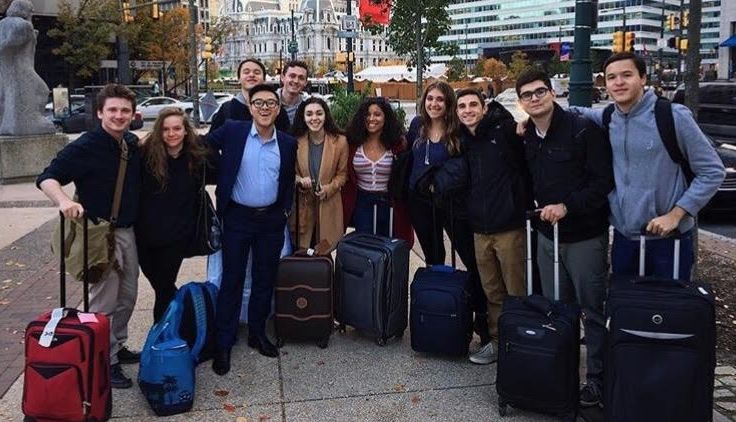Villanova Represented in Model UN Conference
November 27, 2018
Last weekend, Philadelphia hosted the 52nd annual University of Pennsylvania Model UN Conference. Eighty universities, such as Duke, the University of Chicago and Harvard, congregated downtown for a weekend full of debate and delegations. The 1,400 students included 13 Villanovans. UPMUN lived up to its promise of spotlighting the best and brightest college students studying world issues, political debate and diplomacy.
Students turned into delegates over the three days, representing a diverse assortment of countries. Each participant was given his or her assigned country prior to his or her arrival along with being placed in one of the four categories of discourse: General Assembly, Economic and Social Council, Specialized Committees and Crisis Committees. While the Economic and Social Committees tackled issues pertaining to the environment and world health, the Crisis Committees took on varied topics such as Big Baller Brand and the Iranian Supreme National Security. Delegates were kept busy considering a multitude of international concerns and how those related to their home nation.
If one needed some public speaking pointers, the conference did not disappoint. UPMUN has a reputation of being one of the best opportunities available to collegians for honing that craft. Though not all delegates are required to present, it is strongly encouraged. Speaking to one’s group of delegates and the chair, the moderator of the event, in a committee is the primary way for understanding the other countries’ viewpoints and evaluating their validity to come up with a cooperative strategy. Initiating these relationships was triggered by the elementary-school ritual of passing notes during presentations.
Sitting in on these series of speeches meant witnessing some of the most well-trained Model UN students from around the country, as well as picking up on some sneaky techniques for accumulating allies. After the speeches were made, it was unmoderated caucus time. Each chair halted his or her surreptitious note-passing and eavesdropping long enough for the self-assembled groups to create a resolution paper, a compilation of their collective countries’ suggestions to resolve the disputed crisis. Toward the end of the weekend, all delegates voted on the presented propositions of the clustered countries, so the success of a resolution rested in the hands of potentially political enemies.
What would UPMUN be without its notorious nighttime activities? The long days of presenting, researching and scoping out countries to merge with called for much-needed merry mingling with fellow students. DelFest is the peak of these after-hour events, taking place on the conference’s final night once all resolution papers have faced their fate. All countries gathered for an unforgettable Philadelphia-hosted delegate dance, guaranteed for numerous memories to be laughed about at one of the many future conferences.
College-level Model UN can be seen as hyper-competitive, with large doses of strategic posturing from fellow delegates, most of whom have years of experience attending these events. All students aim to give positive recognition to their universities by representing them in the most professional way possible. Model UN pushes participants to consume the latest news and current events, as this is a foundation for understanding the goals of their country and recognizing which countries will share these interests. Thinking from the point of view of another country’s citizen gives delegates the fresh perspective of inspecting the world as a global community, a skill that will need to be mastered if one wishes to go from practicing the concept of mock debates to actually working in a career in international relations, business or law.
Delegates Pictured: Gabriel Cusumano, Angela Marcucci, Ryan Schronder, Waldemar Rodriguez, Joey Rodriguez, Caden Lorenzini, Ha Dinh, Rosie Lynch, Natalie Psyhogeos, Reginald Kossuth, Andrew Vavricka, Isabella Mcilvaine and Pio Jung











